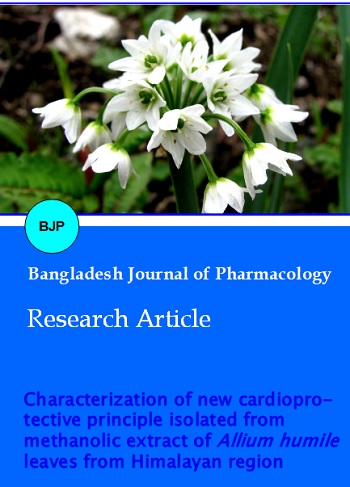Characterization of new cardioprotective principle isolated from methanolic extract of Allium humile leaves from Himalayan region
DOI:
https://doi.org/10.3329/bjp.v11i2.25991Keywords:
Allium humile, Cardioprotective, Himalayan regionAbstract
In modern era scientists have been trying to validate many properties of Allium species, especially in terms of the identity of the active components, their mechanism of action and exploring the potential benefits as food supplements. Thus, the present study has been designed to characterize the isolated cardioprotective compound from Allium humile leaves. Chromatographic purification of the methanolic extract of A. humile leaves isolated ajoene (enol form) (AH-1)- a new potent cardioprotective principle, along with three known compounds allicin (AH-2) and alliin (AH-3) and a flavonoid quercetin (AH-4). The structures of all the isolates (AH-1, AH-2) were characterized by using modern spectroscopic analysis UV, IR, 1H and 13C NMR and mass spectrometry. Furthermore, the new isolated compound pharmacologically conformed for cardioprotective effect. The data of known compounds (AH-2, AH-4) were further compared with the reported data for these compounds.
Downloads
387
303 Read
108

Published
How to Cite
Issue
Section
License
Authors who publish with this journal agree to the following terms:
- Authors retain copyright and grant the journal right of first publication with the work simultaneously licensed under a Creative Commons Attribution License that allows others to share the work with an acknowledgement of the work's authorship and initial publication in this journal.
- Authors are able to enter into separate, additional contractual arrangements for the non-exclusive distribution of the journal's published version of the work (e.g., post it to an institutional repository or publish it in a book), with an acknowledgement of its initial publication in this journal.
- Authors are permitted and encouraged to post their work online (e.g., in institutional repositories or on their website) prior to and during the submission process, as it can lead to productive exchanges, as well as earlier and greater citation of published work (See The Effect of Open Access).
